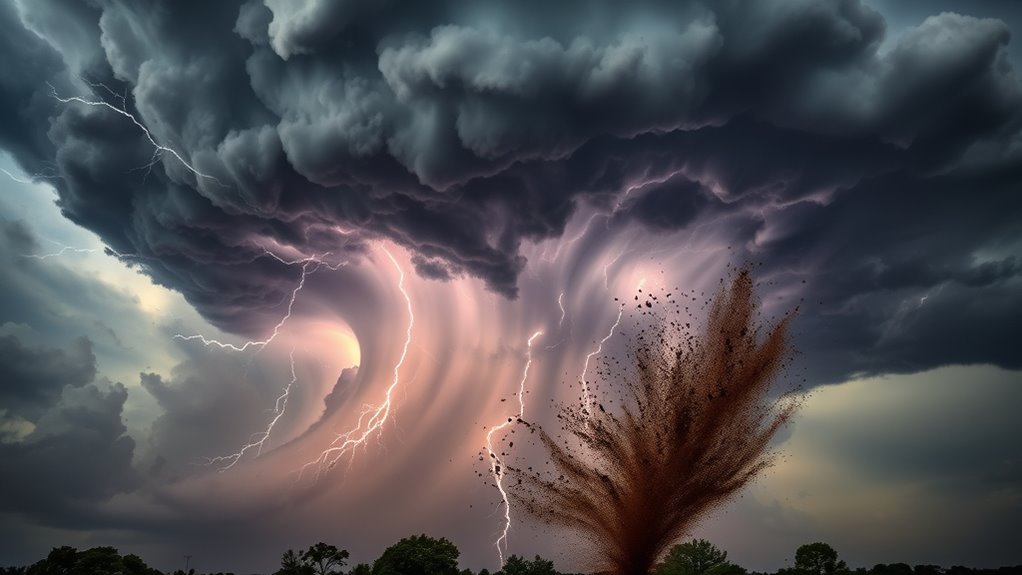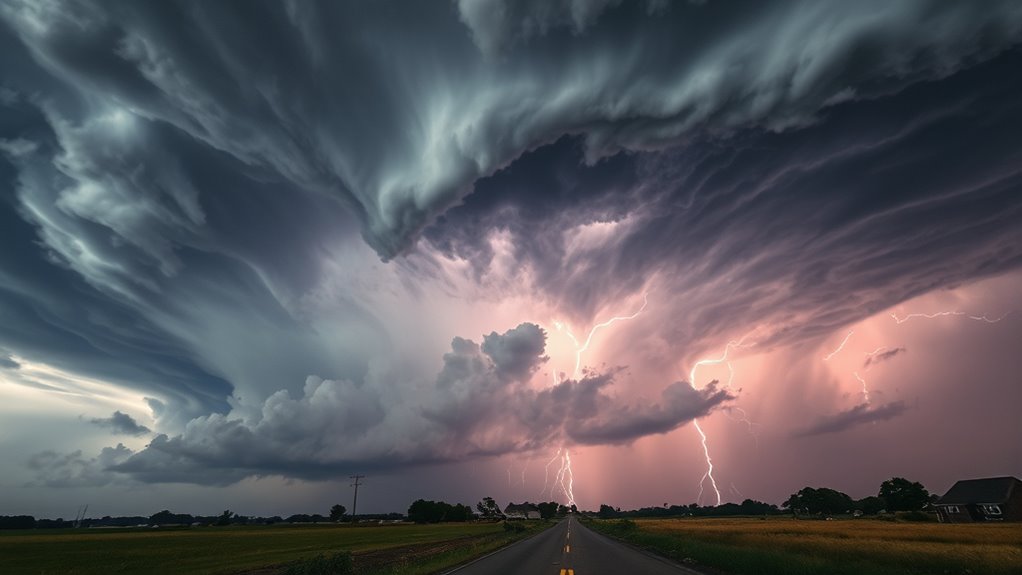Weather hazards like microbursts, gust fronts, and thunderstorm anvils can rapidly impact your safety. Microbursts create intense, localized winds over 100 mph, capable of damaging structures and threatening aircraft during takeoff or landing. Gust fronts appear as sudden wind shifts and temperature drops, potentially triggering new storms. Thunderstorm anvils signal powerful storms with towering clouds. Recognizing these signs helps you stay prepared and safe—continuing will reveal how to spot these dangers before they catch you off guard.
Key Takeaways
- Microbursts are intense downdrafts causing rapid, localized wind damage, often exceeding 100 mph.
- Gust fronts form when descending air hits the ground, spreading out and causing sudden wind shifts and temperature drops.
- Thunderstorm anvil clouds extend miles and signal the presence of severe weather, including microbursts and gust fronts.
- Monitoring storm development and atmospheric conditions is essential for early detection and safety prevention.
- Recognizing visual signs like towering anvil clouds and rapid wind changes helps forecast and respond to weather hazards.

Have you ever wondered how weather can suddenly turn dangerous? One of the most striking examples is the microburst, a sudden, powerful downdraft that can cause widespread damage in seconds. Microburst formation begins when a thunderstorm develops a strong updraft, lifting moist air high into the atmosphere. As this air rises, it cools and condenses, releasing energy that fuels the storm. Eventually, the storm’s heavy precipitation begins to fall rapidly, dragging colder, denser air downward. When this downdraft hits the ground, it spreads out rapidly in all directions, creating a microburst. These bursts are typically less than 2.5 miles across but pack a punch, capable of producing winds over 100 mph. Because microbursts develop so quickly and can be highly localized, they pose a serious threat to aircraft during landing and takeoff, as well as to structures and landscapes suddenly caught in their path. Monitoring storm intensity and atmospheric conditions is crucial for early microburst detection. Simultaneously, gust front dynamics play an essential role in the development and behavior of these microbursts. As the downdraft hits the ground, it spreads out horizontally, forming a gust front—a boundary between the cool, descending air and the warmer, surrounding air. This gust front often appears as a sudden, gusty wind shift, accompanied by a noticeable drop in temperature and a change in wind direction. The interaction between the gust front and the ambient air can trigger new thunderstorms or enhance existing ones, creating a cycle of increasing storm activity. The gust front’s advancing boundary can also cause abrupt changes in wind speed and direction, making outdoor activities and aviation operations particularly hazardous. Understanding gust front dynamics helps meteorologists forecast microburst occurrences and warn communities in time. The danger of microbursts isn’t limited to the intense winds alone. The rapid downdraft can cause a sudden decrease in visibility and destabilize the air around you. This can lead to dangerous flying conditions and sudden structural damage if caught unaware. Microbursts are often associated with intense thunderstorms that produce towering anvil-shaped cloud formations, known as thunderstorm anvils. These anvil clouds extend miles into the atmosphere, indicating the presence of a powerful storm system overhead. They are visual clues that a storm is capable of producing severe weather, including microbursts and gust fronts. By understanding how microburst formation and gust front dynamics work together, you gain insight into the complexity of severe weather systems and the importance of timely warnings. Recognizing these signs can mean the difference between safety and disaster when nature releases its unpredictable fury.
Frequently Asked Questions
How Can Microbursts Be Distinguished From Tornadoes Visually?
You can distinguish microbursts from tornadoes by observing visual cues and shadowing effects. Microbursts typically have a downward, divergent wind pattern with a clear, straight-line wind damage, and they often lack the rotating cloud base seen in tornadoes. Shadowing effects from the storm’s outflow can reveal a straight, spreading gust front, whereas tornadoes usually feature a rotating, funnel-shaped cloud with a more localized, swirling damage pattern.
What Are the Latest Technologies Used to Detect Gust Fronts?
You can spot gust fronts with the latest tech, like radar detection and satellite imagery, which act as your weather radar eyes. These tools detect the sharp temperature drops and wind shifts that signal a gust front’s arrival, much like a weather alarm bell ringing loud and clear. Radar provides real-time data, while satellites give a broad view, helping you stay ahead of severe storms and their gusty boundary lines.
How Do Thunderstorm Anvils Affect Local Climate Conditions?
Thunderstorm anvils are of great importance in influencing local weather conditions and impact aviation safety. They can cause temperature drops, increase humidity, and trigger new storm development nearby. These large cloud tops also modify wind patterns and precipitation, shaping the local climate over time. For pilots, understanding anvil behavior is essential, as it signals potential turbulence and storm intensity, affecting flight routes and safety protocols. Recognizing their influence helps you stay prepared and mitigate risks effectively.
Can Microbursts Occur During Non-Severe Thunderstorms?
Yes, non-severe microbursts can occur during weaker thunderstorms. Microburst formation isn’t limited to severe storms; it can happen when localized downdrafts rapidly descend through the cloud and hit the ground, creating strong, localized winds. These non-severe microbursts still pose hazards, especially to aircraft and structures, even if they don’t produce widespread storm damage. So, always stay alert, even during seemingly mild thunderstorms.
What Safety Measures Are Recommended During a Thunderstorm With Anvil Clouds?
While the sky wears its grand anvil clouds, you should prioritize lightning safety by seeking sturdy shelter away from windows. Avoid open areas, tall objects, and water. If indoors, stay inside, away from conductive surfaces. If caught outside, crouch low, minimizing contact with the ground. Remember, proper shelter selection and avoiding lightning exposure are your best defenses during thunderstorms with impressive anvil clouds.
Conclusion
Understanding microbursts, gust fronts, and thunderstorm anvils helps you stay safer during storms. Think of these hazards as the sudden, powerful surprises in a fireworks show—bright, loud, and intense. By recognizing their signs, you can react quickly and protect yourself. Remember, being informed is like having an umbrella in a downpour—you’re better prepared to weather the storm. Stay alert, stay safe, and respect nature’s unpredictable power.









